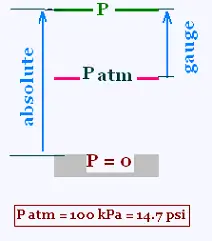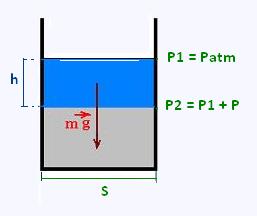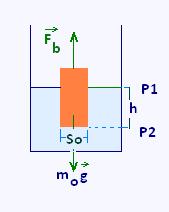Buoyant Forces
1.Pressure

Pressure is the force that is exerted on a unit surface area. It is defined as
the dot product of the vector force and the vector normal to the surface.
P = F . n = |F| |n| cosθ = |F| cos θ.
θ is the angle between the vector n and F. Since
|n| = 1, we have then:
P = |F| cos θ.
Notice that only the component of the force , that is perpendicular
to the surface exerts a pressure on this surface. Only normal force exerts
a pressure.
Pressure is a scalar quantity, so it has no direction. Its SI unit
is the Pa (Pascal) = 1 Newton/m2(N/m2).
The absolute pressure is measured from zero. That is, if we press something, we
just add a pressure above the already existing pressure called the
atmospheric pressure. The added pressure is called gauge pressure.
This added pressure is relative to the ambient atmospheric pressure.
2. Pascal's Principle
It states:
When a pressure is applied to an enclosed incompressible fluid, this pressure
is fully transmitted to every point of the fluid, including the
walls of the container where the fluid is confined.
3.Archimedes' principle
It states:
When an object is immersed in a fluid, the object is buoyed up
by a force that is equal to the weight of the fluid displaced by
this object.
4. Column height pressure

At the top, the absolute pressure P1 is equal to the atmospheric
pressure Patm.
At the
level h, the absolute pressure P2 is equal to the pressure Patm plus the
contribution P of the column fluid of height h. Therefore: P2 = Pa + P
Where:
P is the pressure of the weight of liquid corresponding to the
height h; that is P = F/S = mg/S = ρ V g/S = ρ gh
P = ρgh
5. Buoyant force

5.1. Archimedes' law
The buoyant force replaces the normal force of contact if
an object was at rest on a rigid support. Here, the rigid support is
replaced by an incompressible fluid.
The buoyant force is due to the difference between the pressure at
the bottom surface and the pressure at the top surface. Thus:
Fb/So = P2 - P1 = P = ρf g h
(1)
Where
So is the area of the object at the bottom,
ρf is the density of the fluid.
We have:
Vf = h SoVf the volume of the displaced fluid.
If mf is the mass of fluid displaced, then:
mf = ρf Vf
Therefore:
mf = ρf h So
If Wf = is the weight of the displaced fluid, then:
Wf = mf g = ρf g Vf
= ρf g So h = Fb
Then:
Fb = Wf = ρf g h So = ρf g Vf
The buoyant force is equal to the weight of the fluid's displaced volume.
The buoyant force is equal to the weight of the fluid's displaced volume
Fb = Wf = ρf g h So = ρf g Vf
5.1. Immersed object
Let's denote by ho, Vo, mo,
and ρo the
height, the volume, the mass, and the density of the object respectively, we have:
Fb = So ρf g ho
Vo ρf g
mo = ρo Vo
The object is at rest. According to the Newton's first law, we have:
Fb = mo g
According to (1)
Fb = ρf g h So
Therefore:
mo g = ρf g h So
That is:
ρo Vo g = ρf g Vf
Hence:
ρo Vo = ρf Vf
ρoVo = ρfVf
5.2. Wholly immersed = totally submerged body
For this case, the volume of fluid displaced is equal to the
entire volume of the object.
ρo Vo = ρf Vo
or
Vo (ρo - ρf ) = 0
5.3. Does the object sink or float ?
At a certain level, when the object is wholly immersed (Vo = Vf), if we release the object we will have two cases:
1. Fb > mg:
ρf Vf > ρo Vo
That is with Vf = Vo:
ρf > ρo
So, the object raise to the surface and floats.
ρf > ρo
The object floats
2. Fb < mg:
ρf < ρo
The object falls to the bottom and sinks.
ρf < ρo
The object sinks
|